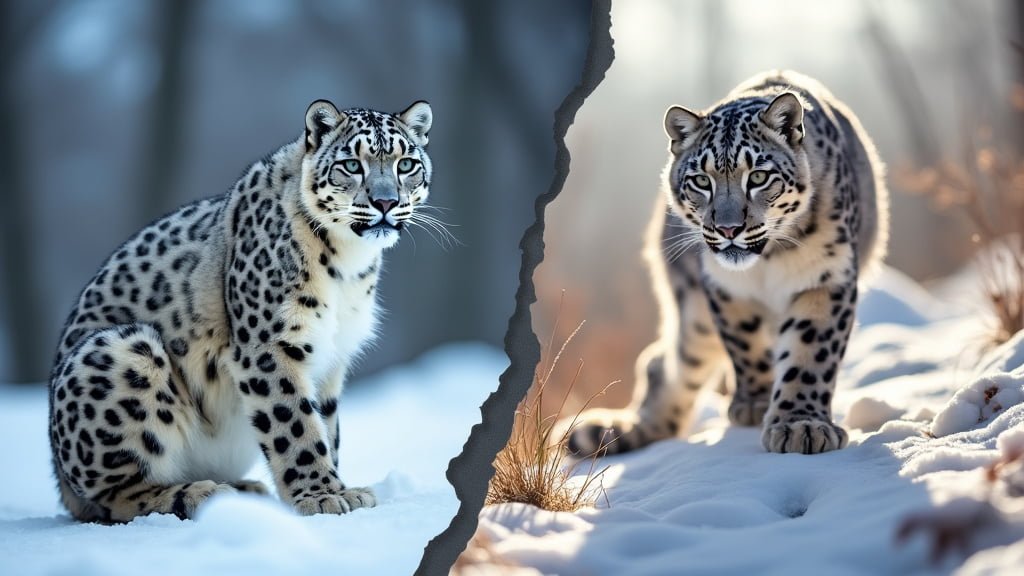Introduction
The distribution of snow leopards across northern and southern Asia varies significantly due to differences in geography, climate, and human impact
This article will explore the regions where snow leopards are most commonly found in northern and southern Asia, their preferred habitats, and the role of mountain ranges like the Himalayas and the Altai in defining these territories
Additionally, we will examine how population densities and conservation efforts differ across these regions, highlighting the unique challenges snow leopards face in the northern and southern parts of their range
Distribution of Snow Leopards in Northern Asia
Snow leopards in northern Asia inhabit some of the most remote and rugged terrains, primarily within the high-altitude mountains of this region
These elusive cats are adapted to the cold and harsh environments of the northern Asian landscapes, where they have carved out territories that span several countries
This section will delve into the key regions in northern Asia where snow leopards are found, the impact of geography and climate on their distribution, and the population densities within these areas
Main Regions in Northern Asia with Snow Leopards
Northern Asia, particularly in countries like Mongolia, Russia, and parts of Kazakhstan, serves as a critical habitat for snow leopards
The Altai Mountains, stretching across the borders of Russia, Mongolia, China, and Kazakhstan, are one of the primary regions where snow leopards thrive. The Sayan Mountains in southern Siberia also host a significant population of these big cats
These areas provide the cold, arid conditions that snow leopards are well adapted to, with their thick fur and large nasal cavities designed to survive in extreme cold
In Mongolia, the South Gobi Desert’s mountains, including the Gobi-Altai and the Tost Mountains, are known snow leopard habitats. Despite the arid environment, the rugged terrain and prey availability make it a suitable habitat
Snow leopards in these northern regions often occupy high-altitude ranges between 9,800 and 14,800 feet above sea level, where they can avoid human disturbances and access their primary prey, such as ibex and wild sheep
Impact of Geography and Climate in Northern Asia
The geography of northern Asia, characterized by expansive mountain ranges and plateaus, plays a crucial role in the distribution of snow leopards. The harsh, cold climates of the Altai and Sayan mountains offer a refuge for these animals, keeping them isolated from human populations
These mountainous regions are often covered in snow for most of the year, aligning with the snow leopards’ physical adaptations, such as their powerful limbs and large paws, which allow them to navigate snowy and rocky terrains efficiently
Moreover, the cold desert climates found in areas like Mongolia’s Gobi Desert further support the presence of snow leopards. These regions experience extreme temperature variations, with very cold winters and hot summers
However, snow leopards are primarily found in areas that maintain cooler temperatures year-round, which is crucial for their survival. The dry climate also reduces vegetation cover, making the rocky terrain ideal for snow leopards to stalk and hunt prey
Population Densities in Northern Asia
The population density of snow leopards in northern Asia varies significantly depending on the region. For example, in the Altai and Sayan mountains, population densities are relatively low, estimated at 0.5 to 1.2 individuals per 100 square kilometers
This low density is due to the vast and rugged nature of the terrain, which supports only a limited number of prey species per unit area
In contrast, certain parts of Mongolia, such as the South Gobi region, report slightly higher population densities, ranging from 1.5 to 3 individuals per 100 square kilometers. This increase can be attributed to the higher availability of prey in the region, particularly in areas where conservation efforts have led to a resurgence in prey species like ibex and argali sheep
Despite these efforts, snow leopard populations in northern Asia remain at risk due to poaching and habitat fragmentation, with recent estimates suggesting that there are around 1,000 to 1,500 individuals in the entire northern range
Distribution of Snow Leopards in Southern Asia
In southern Asia, snow leopards are primarily found in the rugged mountain ranges that span across countries like India, Nepal, Bhutan, and Pakistan. These regions offer diverse habitats, from the alpine zones of the Himalayas to the steep valleys of the Karakoram range
This section will explore the key habitats in southern Asia, the influence of the region’s geography and climate on snow leopard distribution, and the population densities of these elusive cats in these areas
Key Habitats in Southern Asia
Southern Asia is home to some of the most important snow leopard habitats in the world, particularly in the Himalayan and Karakoram ranges. The Himalayas, which stretch across five countries—India, Nepal, Bhutan, China, and Pakistan—are a crucial stronghold for snow leopards
Within India, states like Himachal Pradesh, Uttarakhand, and Jammu and Kashmir host significant snow leopard populations. In Nepal, snow leopards are predominantly found in the Annapurna and Langtang regions, as well as in the Manaslu Conservation Area
The steep, rocky terrain of the Himalayas, combined with the region’s cold alpine and subalpine climates, creates an ideal environment for snow leopards. These areas are characterized by sparse vegetation, which provides excellent camouflage for snow leopards as they stalk their prey
In Bhutan, the Jigme Dorji National Park is a key habitat, where snow leopards are found at elevations between 9,800 and 16,400 feet. The Karakoram range, particularly in northern Pakistan, is another vital habitat, with snow leopards occupying the high-altitude zones and preying on ibex, markhor, and blue sheep
Influence of Southern Asia’s Geography and Climate
The geography of southern Asia, dominated by the towering Himalayas and other significant mountain ranges, profoundly impacts snow leopard distribution
These regions experience extreme climate conditions, with heavy snowfall in winter and cold temperatures persisting throughout the year. Snow leopards are highly adapted to these environments, with their thick fur, short limbs, and large nasal cavities enabling them to withstand the cold and thin air at high altitudes
The varying altitudes in southern Asia also create distinct microclimates, which influence the availability of prey and the movement patterns of snow leopards. For instance, during the harsh winter months, snow leopards may descend to lower altitudes in search of food, as their primary prey, such as blue sheep and Himalayan tahr, migrate to lower elevations
The rugged and often inaccessible terrain further limits human encroachment, allowing snow leopards to maintain territories across vast stretches of land, although this also makes monitoring and conservation efforts more challenging
Population Densities in Southern Asia
Population densities of snow leopards in southern Asia tend to be higher compared to their northern counterparts, although they still remain low overall. In the Indian Himalayas, for example, snow leopard densities have been estimated to range from 0.1 to 5 individuals per 100 square kilometers, depending on the specific region and the availability of prey
In protected areas like the Hemis National Park in Ladakh, densities are on the higher end of this spectrum due to the effective conservation measures in place and the abundance of prey species
Nepal’s population densities are also relatively high in certain areas, particularly within the Annapurna and Langtang regions, where they range from 3 to 5 individuals per 100 square kilometers. These areas benefit from community-based conservation programs, which have helped reduce poaching and human-wildlife conflicts, leading to more stable snow leopard populations
However, in more remote areas of Bhutan and Pakistan, snow leopard densities are lower, often due to the challenges in monitoring and the ongoing threats from poaching and habitat degradation
Differences in Snow Leopard Habitats
Snow leopards inhabit some of the most challenging terrains across Asia, and the differences in their habitats between northern and southern regions reflect the varying environmental conditions and ecological pressures they face
In this section, we will examine the distinctions between the habitats of snow leopards in northern and southern Asia, focusing on the influence of mountain ranges, prey availability, and diet, as well as how these factors contribute to the unique adaptations of snow leopards in each region
Northern vs. Southern Asia Habitats
The habitats of snow leopards in northern and southern Asia differ primarily in terms of altitude, climate, and terrain type. In northern Asia, snow leopards are predominantly found in the cold, dry environments of the Altai, Sayan, and Tien Shan mountain ranges. These regions are characterized by extensive plateaus, steep ridges, and rocky outcrops
The sparse vegetation and colder temperatures here result in a more arid landscape, where snow leopards rely heavily on their thick fur for insulation and their keen eyesight for hunting in open areas
In contrast, southern Asia’s snow leopards inhabit the towering peaks and deep valleys of the Himalayas and the Karakoram ranges. These habitats are more varied in terms of vegetation, ranging from alpine meadows to dense subalpine forests, depending on the altitude
The climate in these regions is also more variable, with significant seasonal changes that affect snow leopard behavior and movement patterns. Snow leopards in the southern regions often have to navigate steeper, more rugged terrain, which can be both an advantage for stalking prey and a challenge in terms of energy expenditure and territory maintenance
Influence of Mountain Ranges in Asia
Mountain ranges are critical to the distribution and survival of snow leopards in both northern and southern Asia. The Altai, Sayan, and Tien Shan ranges in the north are less densely vegetated and receive less precipitation compared to the Himalayas and Karakoram ranges in the south
These northern ranges provide a more predictable, albeit harsh, environment where snow leopards have adapted to hunting in open spaces and enduring long, cold winters with limited resources
The Himalayas, on the other hand, present a more complex environment with varying microclimates and a wider range of ecological niches. Snow leopards here must be more adaptable, often shifting between different altitudes to follow prey migrations and avoid seasonal weather extremes
The dense forested areas at lower elevations in the southern ranges also offer more cover for snow leopards, aiding in their stealthy hunting techniques
Additionally, these mountain ranges act as natural barriers, isolating snow leopard populations and contributing to genetic differentiation between northern and southern groups. This isolation has implications for conservation, as fragmented populations are more vulnerable to genetic bottlenecks and inbreeding
Differences in Prey Availability and Diet
The availability of prey in northern and southern Asia significantly influences snow leopard diet and hunting strategies. In northern Asia, the primary prey species include ibex, argali sheep, and marmots
These animals are well-adapted to the harsh, arid climates and are usually found in higher altitudes where vegetation is sparse. Snow leopards in these regions have evolved to be opportunistic hunters, often relying on ambush techniques due to the open and rocky terrain that provides limited cover
In southern Asia, snow leopards have access to a more diverse range of prey, including blue sheep (bharal), Himalayan tahr, and musk deer. The greater availability of prey in the southern regions often supports higher population densities of snow leopards
However, the steep and rugged terrain of the Himalayas and Karakoram requires snow leopards to be more agile and adaptive in their hunting techniques, often stalking prey over long distances and across challenging landscapes
The diet of snow leopards in southern Asia is also more varied, sometimes including smaller mammals and birds, depending on the availability of their preferred prey
The seasonal movements of prey in these regions, driven by changing weather patterns, force snow leopards to adapt their hunting strategies and territory ranges more frequently than their northern counterparts
Threats and Conservation Efforts
Snow leopards face numerous threats across their range in both northern and southern Asia, including poaching, habitat loss, and human-wildlife conflict. Despite these challenges, various conservation efforts are underway to protect these elusive big cats
This section will explore the specific threats snow leopards encounter in northern and southern Asia, and the conservation programs aimed at mitigating these dangers, highlighting both regional and international initiatives
Threats to Snow Leopards in Northern Asia
In northern Asia, snow leopards face several significant threats, primarily driven by human activities. Poaching remains one of the most pressing issues, as snow leopards are targeted for their pelts and bones, which are highly valued in the illegal wildlife trade
The remote and rugged terrain of the Altai, Sayan, and Tien Shan mountain ranges, while offering some protection, also makes it difficult to enforce anti-poaching laws effectively. Additionally, the demand for livestock grazing land in these areas has led to habitat degradation, further reducing the space available for snow leopards to hunt and breed
Human-wildlife conflict is another critical issue in northern Asia, where herders often retaliate against snow leopards for preying on their livestock. This conflict is exacerbated by the limited availability of natural prey in the region, forcing snow leopards to hunt domestic animals
Programs aimed at mitigating this conflict, such as compensatory schemes for livestock losses, have been implemented in some areas but are not yet widespread enough to have a significant impact across the entire northern range
Climate change also poses a long-term threat to snow leopards in northern Asia. The warming temperatures and changing precipitation patterns are expected to alter the habitats of both snow leopards and their prey, potentially leading to further habitat fragmentation and increased competition with other predators, such as wolves and lynxes
Threats to Snow Leopards in Southern Asia
In southern Asia, the threats to snow leopards are both similar and distinct from those in the north. Poaching remains a significant concern, particularly in regions where enforcement of wildlife protection laws is weak
The demand for snow leopard pelts, bones, and body parts for traditional medicine continues to drive illegal hunting, despite international efforts to curb this trade
Habitat loss due to infrastructure development, such as roads, hydropower projects, and expanding human settlements, is a growing threat in southern Asia, especially in the Himalayas and Karakoram regions
These developments not only fragment snow leopard habitats but also increase human access to previously remote areas, leading to higher incidences of poaching and human-wildlife conflict
Retaliatory killings by herders are also a significant threat in southern Asia, where snow leopards often come into contact with livestock. In regions like Ladakh, India, and parts of Nepal, efforts to reduce this conflict include community-based conservation programs, such as predator-proof livestock pens and compensation schemes for herders. However, the effectiveness of these programs varies, and ongoing efforts are needed to ensure their success
Climate change is another looming threat in southern Asia, particularly in the Himalayas, where warming temperatures are causing glaciers to retreat and altering the availability of water resources
These changes are expected to impact the distribution of both snow leopards and their prey, potentially leading to shifts in their range and increased competition with other species
Conservation Programs Across Asia
Despite the significant threats snow leopards face, various conservation programs have been implemented across Asia to protect these iconic animals
In northern Asia, organizations like the Snow Leopard Trust and Panthera work closely with local communities to reduce human-wildlife conflict and promote sustainable livelihoods. These initiatives include livestock insurance programs, community conservation agreements, and education campaigns to raise awareness about the importance of snow leopard conservation
In southern Asia, countries like India, Nepal, and Bhutan have established protected areas and national parks specifically aimed at conserving snow leopards and their habitats
For example, the Hemis National Park in India and the Annapurna Conservation Area in Nepal are critical refuges for snow leopards, where strict anti-poaching measures and community involvement have helped stabilize populations
Internationally, the Global Snow Leopard and Ecosystem Protection Program (GSLEP) brings together 12 snow leopard range countries, including those in both northern and southern Asia, to collaborate on conservation efforts. This initiative focuses on securing key habitats, reducing poaching, and fostering transboundary cooperation among range countries
Additionally, research and monitoring programs, such as camera trapping and genetic studies, are crucial for understanding snow leopard populations and their ecology. These efforts help inform conservation strategies and enable more effective protection measures to be implemented on the ground
While significant progress has been made in snow leopard conservation, continued efforts and international cooperation are essential to address the ongoing threats and ensure the survival of this magnificent species across its entire range
Conclusion
The distribution of snow leopards across northern and southern Asia reveals significant differences driven by variations in geography, climate, and human impact
In northern Asia, snow leopards inhabit the cold, arid mountain ranges like the Altai and Sayan, where their populations are sparse and face threats from poaching and habitat degradation
In contrast, southern Asia’s snow leopards are found in the more diverse and rugged terrains of the Himalayas and Karakoram, where they contend with habitat loss due to infrastructure development and higher levels of human-wildlife conflict
Despite these challenges, conservation efforts across both regions have made progress, with community-based initiatives, protected areas, and international cooperation helping to stabilize snow leopard populations
However, the ongoing threats of climate change, poaching, and habitat fragmentation underscore the need for continued and enhanced conservation strategies to ensure the survival of snow leopards across their entire range. By addressing these challenges through sustained efforts and global collaboration, there is hope that snow leopards will continue to thrive in the wild for generations to come












